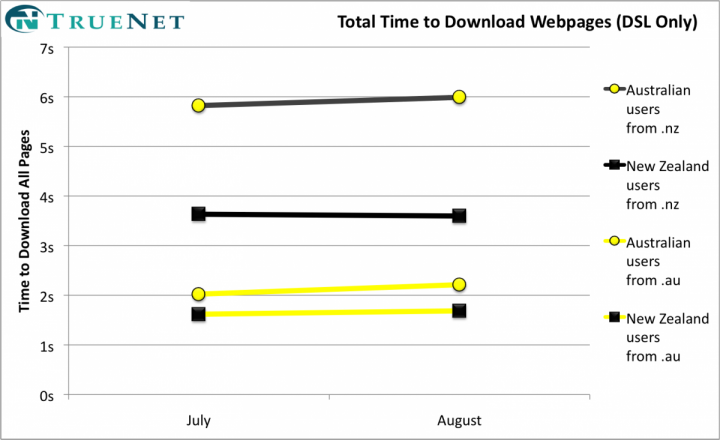Australian Webpages download quicker in NZ
NZ Broadband Policy Years ahead of Australia
2014-08-27
Australian Webpages download quicker in NZ
TrueNet tests show that New Zealand's investment in Fibre to the Node (FTTN) from 2007 to 2011 improved the performance of our telephone line broadband, which is now significantly better than comparable Australian networks.
TrueNet have compared all of our copper line probes (280+) with a small but relevant sample of 12 Australian probes doing exactly the same tests to public Websites in each country.
NZ probes achieve better download times than Australian probes for popular Australian websites.
As expected NZ probes are quicker to download NZ websites.

Chart 1: Comparing NZ & Australian Website downloads to users in each country
We checked the fairness of this by observing the actual performance of probes, and the comparison above reflects the probability that results from any NZ probe is likely to be much better than from one in Australia. A roll out of FTTN in Australia will certainly help improve this lagging performance over copperlines, though NZ continues to move forward with UFB and better broadband performance.
Background
A decision was made in 2006 that the then Telecom would "cabinetise" the nation, committing to "delivering broadband speeds of 10Mbps to eighty percent of New Zealanders by the end of 2011" - See more here
This technology change to FTTN involved installing the exchange-based broadband equipment in roadside cabinets in over 3,600 locations, according to Chorus.
This activity placed New Zealand broadband services well ahead of Australia, where the debate and trials of FTTN are just starting.
NZ's investment in UFB is a further example of major differences in approach across the Tasman; the Australian fibre plan called NBN has just been cancelled in favour of FTTN starting in 2015, eight years after the start of FTTN in NZ. Australian lack of political consensus and action have resulted in this potentially expanding gap between copper broadband performance in the two countries.
Cabinetisation or FTTN: This involves building a large roadside cabinet approximately 2m x 2m x 0.5m and installing exchange equipment inside, fed by a fibre cable from an exchange. The cabinet reduces the length of copper on any connection and so increases the broadband speed, often significantly. Typical copper lengths in NZ are now about 500m with a limit around 1km, although small numbers, mostly rural, remain higher. By comparison, in Australia, without FTTN, copper lengths in the cities are typically 2-4km.
NZ Websites: Blogspot, GrabOne, NZ Dating, Radio NZ, Real Estate, The Warehouse, Trademe Homepage and Wikipedia
Australian Websites: Bureau of Meteorology, NEWS.com.au, 9News and SMH (Sydney Morning Herald)


 Raise Communications: NZ Careers Expo Kicks Off National Tour Amid Record Unemployment
Raise Communications: NZ Careers Expo Kicks Off National Tour Amid Record Unemployment Hugh Grant: How To Build Confidence In The Data You Collect
Hugh Grant: How To Build Confidence In The Data You Collect Tourism Industry Aotearoa: TRENZ 2026 Set To Rediscover Auckland As It Farewells Rotorua - The Birthplace Of Tourism
Tourism Industry Aotearoa: TRENZ 2026 Set To Rediscover Auckland As It Farewells Rotorua - The Birthplace Of Tourism NIWA: Students Representing New Zealand At The ‘Olympics Of Science Fairs’ Forging Pathway For International Recognition
NIWA: Students Representing New Zealand At The ‘Olympics Of Science Fairs’ Forging Pathway For International Recognition Coalition to End Big Dairy: Activists Protest NZ National Dairy Industry Awards Again
Coalition to End Big Dairy: Activists Protest NZ National Dairy Industry Awards Again Infoblox: Dancing With Scammers - The Telegram Tango Investigation
Infoblox: Dancing With Scammers - The Telegram Tango Investigation